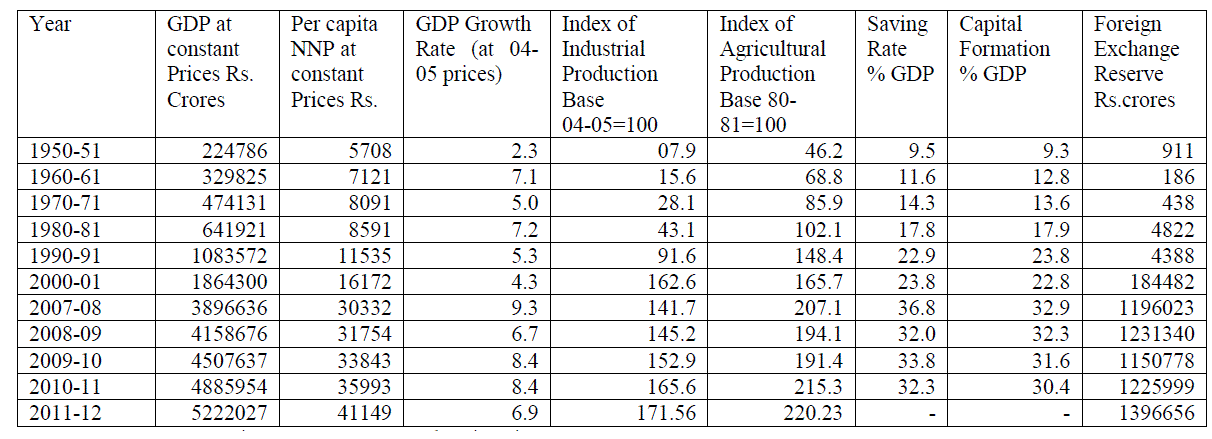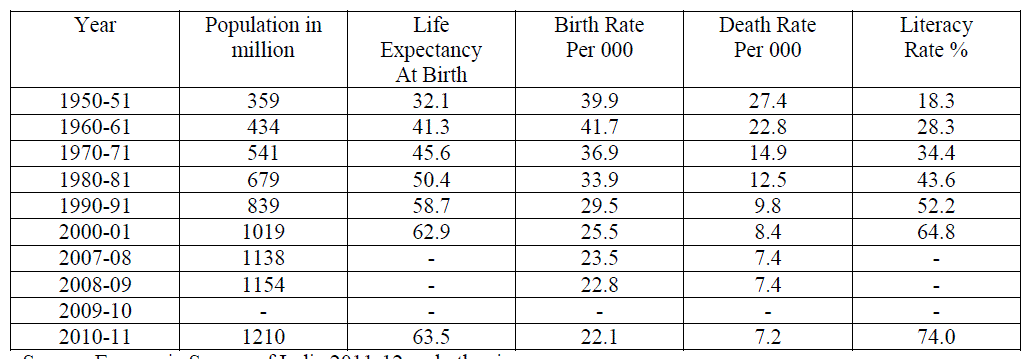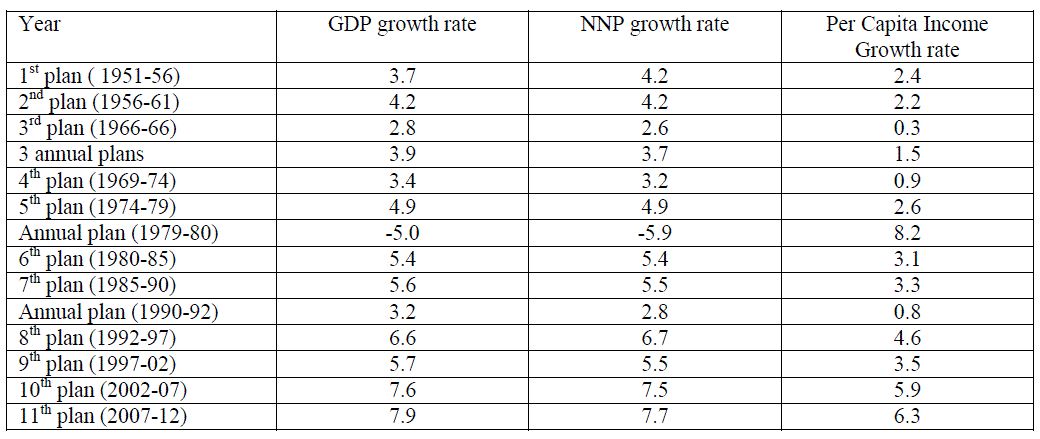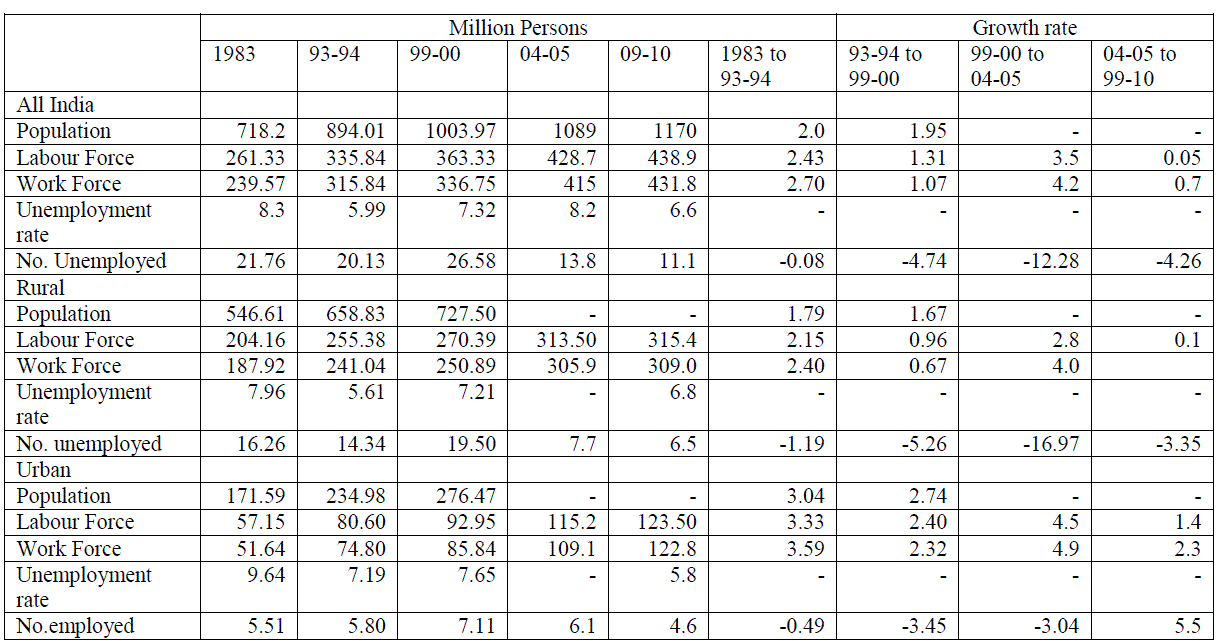ISSN ONLINE(2319-8753)PRINT(2347-6710)
ISSN ONLINE(2319-8753)PRINT(2347-6710)
Kiran.R1, Subashini K2, Dr.M.K.Nagamani3
|
| Related article at Pubmed, Scholar Google |
Visit for more related articles at International Journal of Innovative Research in Science, Engineering and Technology
The study reveals that economic growth which started after independence took momentum after economic reforms were introduced in the economy. Now India is recognized as second fast growing country after china and is emerging as a superpower in the years to come.GDP and per capita income is growing but employment is not growing in the ratio the GDP is growing. There are growing income differences among different income groups. Hence, the concentration of economic power is growing in the country which is a challenge for equitable growth to be undertaken. Efforts need to be made to reduce the differences in income groups.
Keywords |
| Employment –Income-Demand-Production-Employment cycle, Directive principles, Planning Commission of India, gross domestic product (GDP), Capital formation in the country, growth rate of GDP NNP and per capita income, falling birth and death rates, increase life expectancy at birth and literacy rates, occurrence of trade cycle in which boom and slump takes place, economic growth and employment generation. |
INTRODUCTION |
| Income and Employment has always been crucial for economists, sociologists and politicians throughout the ages. Even when the state was governed by kings their performance was adjudged on the basis of the prosperity (economic growth) and employment status of its subjects. Economic prosperity of a country is perceived to be at its maximum, when all of its subjects are optimally and gainfully employed. Employment provides income to a person, which is used to create effective demand for consumption and capital goods in the country. This effective demand in turn leads to increased production of goods and services. This increased production again leads to more employment opportunities and thus an Employment –Income-Demand-Production-Employment cycle is created. Employment is important not only for economic growth but its ramifications have also been on social and political stability and peace in the country. The importance of growth and employment has been recognized in our constitution also as the Directive principles lays down that “the State shall in particular, direct in policy towards securing (a) that citizens, men and women equally have the right to an adequate means of livelihood (b) that the ownership and control of the measures of the community are so distributed as best to sub-verse the common good,(c) that the operation of economic system does not result in concentration of wealth and means of production to common detriment” Keeping in view the Government of India adopted planning as a means of fostering economic development. The Planning Commission of India set out four long term objectives of planning a) to increase production to the maximum possible extent so as to achieve higher level of national and per capita income (b) to achieve full employment (c) to achieve inequalities of income and wealth,(d) to set up socialist society based on equality, justice and absence of exploitation. In this paper an attempt as been made to verify the conceptual issue of link between economic growth and employment generation with regard to India. |
| Economic growth refers to increase in goods and services produced by an economy over time. It is conventionally measured as percentage of increase in real gross domestic product (GDP). Growth is usually calculated in real terms i.e. inflation adjusted terms to make it comparable nationally and internationally. The increase in GDP is supported increase in agricultural and industrial production. When there is economic growth in the country there should be increase in exports and imports as well. The increase in exports should result in increase in foreign exchange reserve in the country. The increase in income of the people should be able to increase the saving and capital formation in the country. Besides, there are some social indicators of economic growth, as well, like falling birth and death rates, increase life expectancy at birth and literacy rates. |
| Employment is the state of engagement of a person in a productive work. It may be either self-employment or wage-employment. In this paper a person has been treated as employed whether it is self-employment, casual labourer or a salaried person working in organized or unorganized sector. |
 |
| Economic Growth in Independent India: |
| After Independence Indian govt.,chose planned growth of the economy on the pattern of the Soviet Union. Though economic growth refers to increase in production of goods and services or the GDP at constant prices, a broader approach of economic growth has been taken in this study. For economic growth to be meaningful it should not only increase the Gross Domestic Product (GDP) and per capita income of the people, but there should also be corresponding increase in saving and Capital formation in the country. Besides the export and import of the country should also shows the increasing trend. On the other hand the growth should have the positive impact on the quality of the life of the people. The better quality of life of the people is reflected by falling birth and death rates and increasing life expectancy and literacy of the people. On the above parameters the growth of the country have been appraised with the result as under-Table 1 shows that the Gross Domestic Product (GDP) of India has grown from 224786 crores in 1950-51 to 5222027 crores in 2011-12 and it has constantly risen. The pace of growth has increased from initial 2.3 per cent in 1950-51 to 9.3 per cent in 2007-08. The growth rate latter slowed down due to financial crisis erupting in European countries and spreading over the world. Likewise the per capital income of the country has also grown from 5708 crores in 1950-51 to Rs.41149 at constant prices. The other indicators like imports, exports, savings and capital formation has also shown increasing trend throughout the years. |
 |
| The impact of increase in GDP has positive impact on the quality of life of the people as the social indicators presented in Table-2 show decreasing birth and death rates (Per 000) which were 39.1 and 27.4 respectively in 1950-51 has fallen constantly throughout years and has reached to 22.1 and 7.2 respectively in the year 2011-12. Due to fall in death rates life expectancy has increased from 32.1 years to 63.5 years in the year 2011-12 .Literacy rates have also gone up from 18.3 per cent in 1950-51 to 74 per cent in 2011-12. |
 |
| Table-3 shows the country‟s average annual growth rate. As this table shows GDP and NDP growth rate was negative during annual Plan (1979-80) from 6th play they show the increasing trend. The country have passed through three distinct phase of economic growth strategy. The period 1950-51 to 1980-81 is considered as the controlled period. In this period the public sector was playing dominant role in the economy. The private sector investment was very limited and subject to strict scrutiny license and permits. The private capital investment was very limited and subject to strict govt., scrutiny, license and permit. The period 1980-90 is considered as transitory period in which control on economy was relaxed cautiously and after 1991 deregulation and liberalization of the economy begin. In this period private sector investment was being encouraged to boost the economic growth and employment generation in the country. The growth of the economy should be examined considering the policy adopted in these distinct phases for better understanding. Table-3 shows plan wise growth rate of GDP NNP and per capita income. As is evident from the table the economy grew at less than 5 (average 3.5%) annually in the period 1951-1980 of strict government control which is regarded as Hindu rate of growth. As the government control and regulation was eased the growth rate increased and reached to more than 5% in the period 1980-90 and further to nearly 10% after economic reforms was introduced in the country. |
 |
| Table-4 presents the India‟s share in world economy. All the parameters selected shows a growing share of India in world economy. The GDP which was just 1.7% in 1980 has risen to 2.6% in 2010. Service export has also increased from 0.7% in 1980 to 3.3% in 2010. Since the birth rate is falling, the dependency rate has decreased from 75.9 to 55.1 making saving and capital formation rate has been increasing. Increasing old age dependency rate may be a matter of concern for the economy as the country will have to make necessary provisions for increasing number of elders who cannot contribute anything to the country. |
| Employment generation in India: |
| After the Independence one of the basic aim of economic planning has been employment generation in the country. Till 1970 the government followed the „tickle down‟ theory of employment that considers that the growth itself will bring employment generation. Afterwards it realized that the employment is not increasing at the pace the economy is growing. Due to reduction in death rates population and workforce kept on increasing. Besides owing to several constrains the skill development could not kept pace with technological progress in the world and hence the government had to start special employment programs, among which the following have been prominent –Maharashtra Employment Guarantee scheme (1971/72), Food For work (1977). National Rural Employment Programmed 1980 (replacing food for work programmer), Rural Landless Employment Guarantee programmer 1983,Jawahar Rojgar Yogana 1989/90 and Special Employment Programme of Gujarat 1991. |
 |
| Table 5 shows macro employment scenario in India from 1983 to 2009-10 as revealed by the table the employment on CDS basis is growing constantly and unemployment together with its rate is coming down but the growth of employment is not in pace with population and labour force growth in the country. Employment has grown at the rate of 0.92% during 1972-73 to 1983 ,2.08% during 1977-78, 2.43% during 1983 to 1993-94, 1.31% during 1993- 94 to 1999-00, 3.05% during 1999-00 to 2004-05 and only 0.05% during 2004-05 to 2009-10. It is important to know that employment in urban areas have grown more rapidly than in rural areas where it ought to be. |
| Evaluation of economic growth in India and its impact on employment: |
| Table -6 presents the share of workforce in broad status of employment in 2009-10. There are more casual workers (male & female) in rural areas than regular wage/salaried employee. People in rural areas either work in their own field or work as a casual labour and there are no regular source of employment available to them. In the urban areas regular wage/salaried employees outnumber casual workers and the ratio of regular salaried people to selfemployed are near one. |
 |
| An analysis of economic growth and employment reveal that the public sector which was very dominant during the license and permit period could not deliver much to the country with regard to economic growth and employment generation. The economy did grow but at very low rate (average) of 3.5 annually. As the control eased the rate of growth of the economy accelerated. Due to global economic condition the economic growth slowed down a bit but the rising trend is still about 7% which is considered a high rate of growth. As a free economy is criticised on the basis of occurrence of trade cycle in which boom and slump takes on regularly. This feature is being seen in the context of Indian economy also. It may be noted that the public sector is still in dominant position. In India the effect of trade cycle is less pronounced in the economy. So far as the employment is concerned the introduction of economic reforms have brought more employment in the country but the rate of growth of employment have not been accelerated very much so as to bring full employment in near future. Since population growth rate is narrowing, the unemployment situation is being less severe. |
CONCLUSION |
| On the basis of this deliberation it is evident that economic growth which started after independence took momentum after economic reforms were introduced in the economy. Now India is recognized as second fast growing country after china and is emerging as a superpower in the years to come.GDP and per capita income is growing but employment is not growing in the ratio the GDP is growing. There are growing income differences among different income groups. Hence, the concentration of economic power is growing in the country which is a challenge for equitable growth to be undertaken. Efforts need to be made to reduce the differences income groups. |
ACKNOWLEDGEMENTS |
| Authors thank Dr.W.P. Martin, Dean – Martins Academy, Bangalore for his support and encouragement |